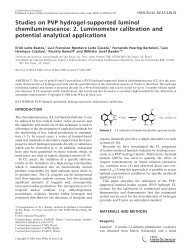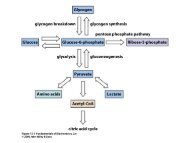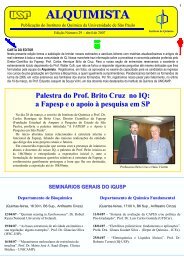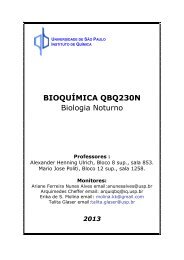Evolution of Sesquiterpene Lactones in Angiosperms*
Evolution of Sesquiterpene Lactones in Angiosperms*
Evolution of Sesquiterpene Lactones in Angiosperms*
You also want an ePaper? Increase the reach of your titles
YUMPU automatically turns print PDFs into web optimized ePapers that Google loves.
158<br />
VICENTE DE P. EMERENCIANO, MARIA AUXILIADORA C. KAPLAN AND OTTO R. GOTTUEB<br />
TABLE 6.--CONTINUED<br />
75611. 757/1, 760/1. 762/1, 88711, 88811, 8~9/1; C/mmaeme/um 28111; ~nthemum 1/2, 112/2. 166/1, 18012, 397/1, 42611. 588/1, 59411,<br />
56211, 67711, 678/1, T/0/1, T/6/2, 79511. 895/2, 912/1. ~6/1, S82/1 ; Co~/a 111, 44'1, 76112. 79511 ; Handelia 25/1, 876/1. 985/1, 96311 ; Lidbectua 761/1 ;<br />
Ma~r~ 111, 120/1, 753/1, g03/1, 905/1, 906/1, 912/1, 932/1, 933/1, 1312/1 ; Osm/I<strong>of</strong>~ 813/1.967/1, ~6/1; Penm;a 775/1; Peymusea 761/1;<br />
Tanace~um 112/t, 182/1, 27~/1, 425/1, 440/1, 58811, ~0/1, ~=84/1, 611/1, 682/1, 67711, 6"/9/1. 875/1, r/6/1. 102o/1; (Am/n/a 156/1, 158/1, 156.5/1, 157/1,<br />
351/1.<br />
13. Amic<strong>in</strong>eee<br />
Anna 104912,1049.§/1, 1190/2, 11~5/1, 11S7/1,1206/1, 1207/2,1206/1, 1209/1, 1211/1, 121511; C/menac~ 11/2; EnOphy//um 11/1, 80/1, 81/1, 83/1,<br />
304/1. 30511, 306/1, 31511, 524/1, 62511, 74011, 74111, 106111;/.a~t~w/e ~S/2, ~6/1. 1Z~1.712; Peucepht4um 285/1.<br />
14. Senecione~e<br />
Bedford= 1050/1.1051/1, 1290/1. 1291/1 ; CacaJb 12~2/2, 134111. 1347/1; Eu~t~os 1267/1,126~/1; Homo91~e 1~92/1. 12¢J~/1. 1300/1; Lygu~r~ 127011.<br />
127612, 1277/1, 12~2/1, 1283/1, 12~8/2. 12~9/1. 1292/30 129S/1. 130011; Pemw~s 1271/2, 1272/1. 1273/2. 1274/2, 1275/2, 1276/3,127711, 1292/4.<br />
1293/1. 129411. 128511. 1297/1, 12S8/1, 130111, 134611; Se~ck, 747/1. 74811, 748/1. ~0/1, 7~1/1, 75211, 126211. 1263/1, 126411,1~6/1, 1278/1. 12"/9/1,<br />
1280/1. 1286/1, 12~7/1. 12~2/1.<br />
TABLE 7. EVOLUTIONARY ADVANCEMENT PARAMETERS OF TAXA<br />
WITH RESPECT TO SKELETAL SiIECJALIZATION AND OXIDATION LEVEL<br />
OF SESQUWERPENE LACTONES<br />
Genera<br />
Taxa EA5 F, Ao<br />
Tribes or families (except Astersceee)<br />
Family (Asteraceae)<br />
TEA5 <strong>of</strong> tribe<br />
[F-Ao <strong>of</strong> tribe<br />
t !<br />
S--ikeletal q~cialization, O--oxidltion level <strong>of</strong> I com¢x)und, n--<br />
number <strong>of</strong> i~ecies <strong>of</strong> the taxo~ <strong>in</strong> which the compound occurs,<br />
t--number <strong>of</strong> tribes.<br />
additionally produces type 1.5 is even more<br />
similar to the Apiaceee, chiefly if the Vemonieae<br />
are considered to be peripheral. The sasquiterpene<br />
lactone data <strong>of</strong> this tribe are close to the<br />
data for Eupetorieee, which, although it was<br />
formerly <strong>in</strong>deed considered to be ak<strong>in</strong> to Vernonieae<br />
[10], is placed <strong>in</strong> Asteroideae group 2 by<br />
Wagenitz [9]. In this group aff<strong>in</strong>ities can be<br />
detected easily by <strong>in</strong>spection <strong>of</strong> the registry <strong>of</strong><br />
the skeletal types (Table 12). Heliantheae, Inuleae<br />
and Anthemideee are def<strong>in</strong>itively very different<br />
from Senecioneas where eremophilanolidas are<br />
formed exclusively.<br />
An EAslEA o correlation (Fig. 9) provides a<br />
dynamic picture <strong>of</strong> this situation, reveal<strong>in</strong>g not<br />
only the aff<strong>in</strong>ity <strong>of</strong> Cichorioideee and Asteroideae,<br />
group 1, the distance <strong>of</strong> Anthemidase from<br />
Asteroideee, group 2 [9], and the relationship <strong>of</strong><br />
Amic<strong>in</strong>eae and Heliantheee [11], all anticipated<br />
on morphological grounds, but also the existence<br />
<strong>of</strong> two major directions <strong>of</strong> sesquiterpene<br />
lactone development. One direction encompasses<br />
the tribes <strong>of</strong> Asteroideee, group 1 and<br />
Cichorioideae, and the pair Vernonieae-Eupetorieae<br />
is <strong>in</strong>deed situated on one <strong>of</strong> its extremes.<br />
The other direction encompasses the tribes <strong>of</strong><br />
Asteroideae, group 2, to which Senecioneae is<br />
only distantly related.<br />
Also <strong>in</strong> a/~s//~ o correlation cluster<strong>in</strong>g <strong>of</strong> po<strong>in</strong>ts<br />
represent<strong>in</strong>g tribes is observed (Fig. 10). Structural<br />
variation <strong>of</strong> sesquiterpene lactones is<br />
TABLE 8. EX1REME S N~ID O VALUES OF SESQUITERPENE LACTONES AND EVOL~Y<br />
ANGIOSPERMS<br />
ADVANCEMENT PARAMETERS FOR FAMlUES OF<br />
~ex s s /~ EA= O 0 ~o EA~<br />
[7] m<strong>in</strong> max m<strong>in</strong> max<br />
Megnolieceae 25 0.13 0.26 0.13 0.20 -1.06 -0.~6 0.40 -0.90<br />
Laursceee 52 0.26 0A0 0.14 0.30 -1.06 -0.26 0.80 -0.83<br />
A~=/~ace~e 51 0.13 0.53 0.40 0,28 -1.06 -0.53 0.53 -0.70<br />
Alterm 72 0.13 0~10" 0.67" 0.32 --1.20 0.00 1.20 --0.78<br />
"The extraord<strong>in</strong>arily high S v~ue$, 0.93 and 1.00, for two r.oml~ourRb we~ excluded.



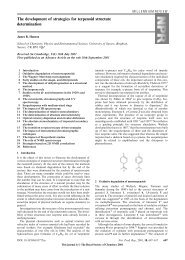
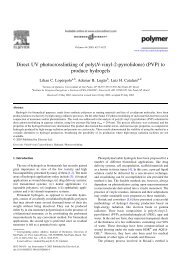
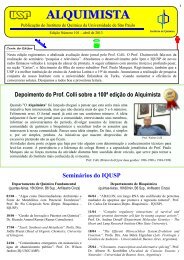
![PE]+ + N. Fragmentação por clivagem sigma](https://img.yumpu.com/50134385/1/180x260/pe-n-fragmentaaao-por-clivagem-sigma.jpg?quality=85)
